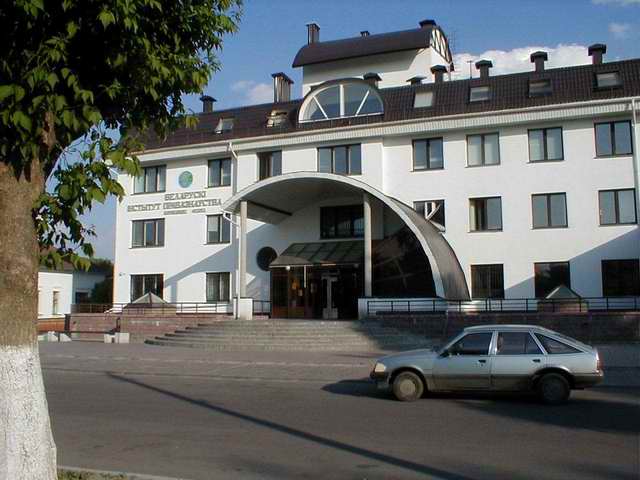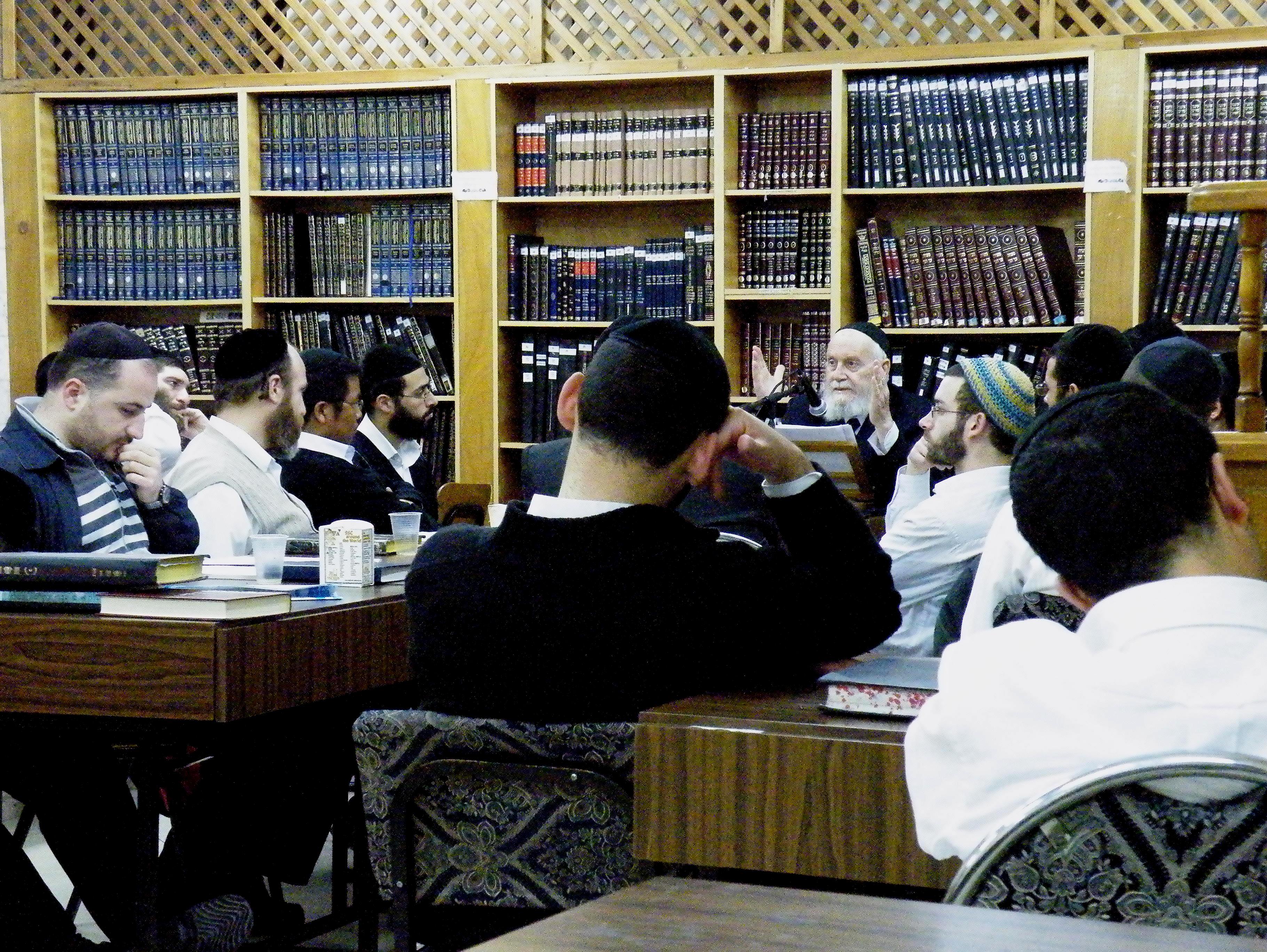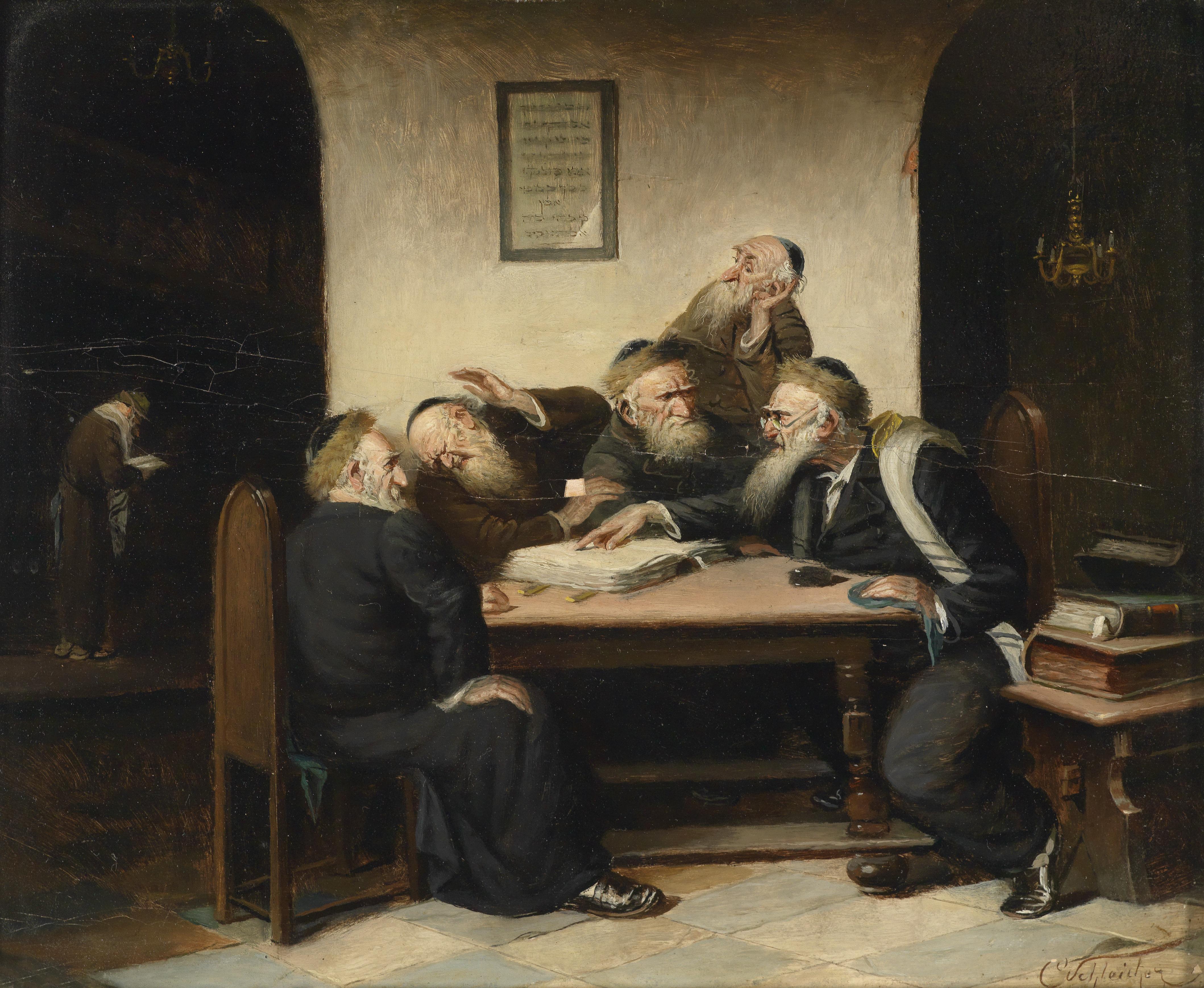|
Yeshiva Ohel Torah-Baranovich
Yeshiva Ohel Torah-Baranovich, commonly referred to as the Baranovich Yeshiva or simply as Baranovich, was an Orthodox Jewish yeshiva in Baranavichy, Belarus (which at its founding was ruled by the Russian Empire and after World War I, the Second Polish Republic). Established circa 1906 by Rabbi Yosef Yoizel Horowitz, the Alter of Novardok (Navahrudak), it attracted leading rabbis such as Rabbi Yisroel Yaakov Lubchansky and Rabbi Avraham Yoffen as instructors, but was forced to disband with the outbreak of World War I. After the war, Rabbi Elchonon Wasserman, a student of the Radin Yeshiva who had been forced into exile in Smilavičy during the hostilities, agreed to serve as rosh yeshiva (dean) upon the recommendation of the Chofetz Chaim. In the interwar period, the yeshiva gained widespread fame and a large student body. Wasserman's style of teaching emphasized the simple meaning of the Talmudic texts and students advanced to the point that they were able to study independent ... [...More Info...] [...Related Items...] OR: [Wikipedia] [Google] [Baidu] |
Baranavichy
Baranavichy or Baranovichi is a city in the Brest Region of western Belarus. It serves as the administrative center of Baranavichy District, though it is administratively separated from the district. As of 2025, it has a population of 170,817. It is home to an important railway junction and to Baranavichy State University. General information The city of Baranavichy is located on the Baranavichy Plain in the interfluve of Shchara and its tributary Myshanka. Baranavichy is located virtually on a straight line, connecting the regional center Brest (206 km) and Minsk (149 km). Nearby cities include Lyakhavichy (17 km), Slonim (42 km), Nyasvizh (51 km), Navahrudak (52 km), and Hantsavichy (72 km). Baranavichy is located on flat terrain where the height difference does not exceed 20 m (from 180 to 200 m above sea level). The altitude of the city is 193 m above sea level. The total length of the city is 10 km from west to east and 7 km from south to north. The city is somew ... [...More Info...] [...Related Items...] OR: [Wikipedia] [Google] [Baidu] |
Radin Yeshiva
The Radin Yeshiva, originally located in Radun, Belarus, Radun, Vilna Governorate, Russian Empire (now in Belarus), was established by Rabbi Israel Meir Kagan (known as the ''Chofetz Chaim'' after the title of his well-known ''Sefer (Hebrew), sefer'') in 1869. Because of its founder's nickname, the institution is often referred to as Yeshiva Chofetz Chaim of Radin. Its successors officially adopted this name. Origins In 1869 when the Chofetz Chaim returned from Vasilishki to Radun his first action was to establish a group to whom he could spread the knowledge of Torah. The founding of the yeshiva is mentioned in one of the letters of the Chofetz Chaim: :''"The beginning of the founding began from when I returned from the town of Vashilyshok...in the year 1869. Following my arrival in Raduń, the Almighty stirred my spirit to gather young students and scholars for the study of Torah..."'' Although at the time Raduń was practically an isolated village, away from undesirable urba ... [...More Info...] [...Related Items...] OR: [Wikipedia] [Google] [Baidu] |
David Rappoport
Rabbi David HaKohen Rappoport () (1890 – September 23, 1941) was an Orthodox Jewish rabbi in Baranovich, Belarus (then part of Poland). He is known for leading Yeshiva Ohel Torah in Baranovich alongside Rabbi Elchonon Wasserman. Early life Rabbi Rappoport was born in Minsk, Russian Empire, in 1890. On his father's side, he descended from Rabbi Akiva Eiger, and on his mother's side from the Vilna Gaon. His father was Rabbi Akiva Rappoport (named for his ancestor, Rabbi Akiva Eiger) and his mother was Chaya Sara Rappoport. As a youngster, David would study Torah in the synagogues and shteiblach (small synagogues) of Minsk, with barely any instruction. Even during the night, after his family would go sleep, he would leave the house to study Torah until dawn, after which he'd come home for a short nap, and awaken at the same time as the others in his home. During World War I, the family had to escape Minsk and found refuge in the German city of Danzig, where his fathe ... [...More Info...] [...Related Items...] OR: [Wikipedia] [Google] [Baidu] |
Shlomo Heiman
Shlomo Heiman (1892–1944) known informally as "Reb Shlomo", was a rabbi, Talmudist, and rosh yeshiva. He led some of the most prominent yeshivas in Europe and the United States. Early life Shlomo Heiman was born in Paritsh, Minsk in Belarus to Michel Heiman, a rabbi. When he was 12, he went to the yeshiva in Kaminetz to study under Baruch Ber Lebowitz, with whom he was very close. In 1918, he married the daughter of Yochanon Rudensky of Volozhin, the brother-in-law of Simcha Zelig Riger of Brisk, the dayan for the Brisker Rav. After his marriage, Lebowitz asked Heiman to be a lecturer at the yeshiva in Kaminetz, which by this time had been wandering from Slobodka to Krementchug. It was at this time that Heiman developed a reputation for being one of Lithuania's most outstanding Talmudists. During World War I, he was briefly drafted into the Russian army. However, he still managed to review the entire tractate of Ketubot while serving on the front lines in the tren ... [...More Info...] [...Related Items...] OR: [Wikipedia] [Google] [Baidu] |
Shiur (Torah)
A shiur (, , ; , ) is a lecture given any Torah-related topic of Torah study, study, such as Gemara, Mishnah, ''Halakha'' (Jewish law), or Tanakh (Hebrew Bible), usually given in a yeshiva, though commonly in other Jewish communal settings. History The Hebrew term שיעור ("designated amount") came to refer to a portion of Judaic text arranged for study on a particular occasion, such as a Bereavement in Judaism#Annual remembrances, yahrzeit, the dedication of a new home, or the evening of a holiday, and then to a public reading and explanation of the same. The act of teaching and studying these texts at the designated time was known as ''shiur lernen'' (); by synecdoche, the act itself became known as ''shiur''. These shiurim would be attended by all classes of people; it was traditional for learned attendees to engage the lecturer in continuous discussion, and for the larger lay audience to listen intently. Concurrently, in the yeshiva-setting it came to refer to ... [...More Info...] [...Related Items...] OR: [Wikipedia] [Google] [Baidu] |
Radin
Radin is a surname and given name. Given name Radin (Persian: رادین) is also an Ancient Persian given name meaning "gentleman". Surname Notable people with the surname include: * Adolph Moses Radin (1848–1909), Polish-American rabbi * Charles Radin (graduated 1965), American mathematician * Dean Radin (born 1952), researcher and author *Furio Radin (born 1950), Croatian politician * Gary Radin, American designer, author and philanthropist *George Radin (1931–2013), American computer scientist * Igor Radin (1938–2014), Serbian ice hockey player *Judi Radin (born 1950), American bridge player *Joshua Radin (born 1974), American songwriter * Margaret Jane Radin (born 1941), American legal academic * Max Radin (1880–1950), American legal scholar and author * Milan Radin (born 1991), Serbian footballer *Nikolai Radin (1872–1935), Russian stage and silent film actor and director *Paul Radin (1883–1959), American anthropologist * Roy Radin (1949–1983), American sh ... [...More Info...] [...Related Items...] OR: [Wikipedia] [Google] [Baidu] |
Soviet Union
The Union of Soviet Socialist Republics. (USSR), commonly known as the Soviet Union, was a List of former transcontinental countries#Since 1700, transcontinental country that spanned much of Eurasia from 1922 until Dissolution of the Soviet Union, it dissolved in 1991. During its existence, it was the list of countries and dependencies by area, largest country by area, extending across Time in Russia, eleven time zones and sharing Geography of the Soviet Union#Borders and neighbors, borders with twelve countries, and the List of countries and dependencies by population, third-most populous country. An overall successor to the Russian Empire, it was nominally organized as a federal union of Republics of the Soviet Union, national republics, the largest and most populous of which was the Russian SFSR. In practice, Government of the Soviet Union, its government and Economy of the Soviet Union, economy were Soviet-type economic planning, highly centralized. As a one-party state go ... [...More Info...] [...Related Items...] OR: [Wikipedia] [Google] [Baidu] |
Torah Study
Torah study is the study of the Torah, Hebrew Bible, Talmud, responsa, rabbinic literature, and similar works, all of which are Judaism's Sifrei kodesh, religious texts. According to Rabbinic Judaism, the study is done for the purpose of the ''mitzvah'' ("commandment") of Torah study itself. This practice is present to an extent in all religious branches of Judaism, and is considered of paramount importance among religious Jews. Torah study has evolved over the generations, as lifestyles changed and also as new texts were written. Traditional view In rabbinic literature, a heavy emphasis is placed on Torah study for Jews, Jewish males, with women being exempt. This literature teaches an eagerness for such study and a thirst for knowledge that expands beyond the text of the Tanakh to the entire Oral Torah. Some examples of traditional religious teachings: * The study of Torah is "equal to all" of the ''Mitzvah, mitzvot'' of Honour thy father and thy mother, honouring one's pare ... [...More Info...] [...Related Items...] OR: [Wikipedia] [Google] [Baidu] |
Talmud
The Talmud (; ) is the central text of Rabbinic Judaism and the primary source of Jewish religious law (''halakha'') and Jewish theology. Until the advent of Haskalah#Effects, modernity, in nearly all Jewish communities, the Talmud was the centerpiece of Jewish culture, Jewish cultural life and was foundational to "all Jewish thought and aspirations", serving also as "the guide for the daily life" of Jews. The Talmud includes the teachings and opinions of thousands of rabbis on a variety of subjects, including halakha, Jewish ethics, Jewish philosophy, philosophy, Jewish customs, customs, Jewish history, history, and Jewish folklore, folklore, and many other topics. The Talmud is a commentary on the Mishnah. This text is made up of 63 Masekhet, tractates, each covering one subject area. The language of the Talmud is Jewish Babylonian Aramaic. Talmudic tradition emerged and was compiled between the destruction of the Second Temple in 70 CE and the Arab conquest in the early seve ... [...More Info...] [...Related Items...] OR: [Wikipedia] [Google] [Baidu] |
Peshat
''Peshat'' (also ''P'shat'', ) is one of the two classic methods of Jewish biblical exegesis, the other being Derash. While ''Peshat'' is commonly defined as referring to the surface or literal (direct) meaning of a text,Goldin, S. (2007). Unlocking the Torah Text: Bereishit. Gefen Publishing. or "the plain literal meaning of the verse, the meaning which its author intended to convey", numerous scholars and rabbis have debated this for centuries, giving ''Peshat'' many uses and definitions.Garfinkel, Stephen. "Clearing Peshat and Derash." Hebrew Bible/Old Testament - The History of Its Interpretation. Comp. Chris Brekelmans and Menahem Haran. Ed. Magne Sæbø. Göttingen: Vandenhoeck & Ruprecht, 2000. 130-34. Print. ''Peshat'' is most often defined as "straight," in reference to its tendency to describe the meaning of the text apparent at face value, taking into account idiomatic expressions, and focusing mostly on literal interpretation. It is often considered the most straight ... [...More Info...] [...Related Items...] OR: [Wikipedia] [Google] [Baidu] |
Interwar Period
In the history of the 20th century, the interwar period, also known as the interbellum (), lasted from 11 November 1918 to 1 September 1939 (20 years, 9 months, 21 days) – from the end of World War I (WWI) to the beginning of World War II (WWII). It was relatively short, yet featured many social, political, military, and economic changes throughout the world. Petroleum-based energy production and associated mechanisation led to the prosperous Roaring Twenties, a time of social mobility, social and economic mobility for the middle class. Automobiles, electric lighting, radio, and more became common among populations in the developed world, first world. The era's indulgences were followed by the Great Depression, an unprecedented worldwide economic downturn that severely damaged many of the world's largest economies. Politically, the era coincided with the rise of communism, starting in Russia with the October Revolution and Russian Civil War, at the end of WWI, and ended with ... [...More Info...] [...Related Items...] OR: [Wikipedia] [Google] [Baidu] |





